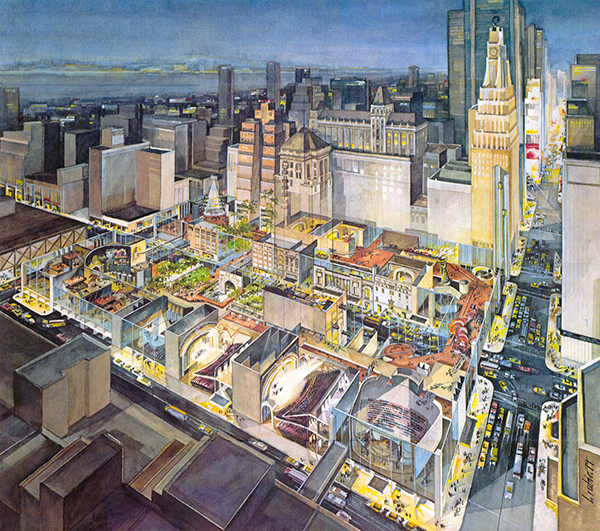The Skyscraper Museum is devoted to the study of high-rise building, past, present, and future. The Museum explores tall buildings as objects of design, products of technology, sites of construction, investments in real estate, and places of work and residence. This site will look better in a browser that supports web standards, but it is accessible to any browser or Internet device.
THE CITY AT 42nd STREET

Image: Poster of "The City at 42nd Street." Courtesy of Cooper, Robertson & Partners.
This colorful poster, a rendering by the delineator Lydia Rubio, created for The City at 42nd Street, pictures the goal of the project in a wholly different graphic language than the drawings by Chermayeff and Geismar, seen in the adjacent case, whose axonometric angles and primary colors present a more rationalist, architectural description of the project. Photographs of (lost) models likewise suggest clean lines and geometric forms of a modernist aesthetic.
The Rubio birds-eye view, however, is a drawing worthy of inclusion in Rem Koolhaas's compendium of crazy projects compiled in his contemporary masterpiece Delirious New York (1978). The drawing is as heady and fanciful as the prose proffered in the bullet blurbs that described the individual projects, which included a 15-story indoor ferris wheel and the world's largest movie screen, as well as a "Museum of Museums," and "a simulated vertical experience - a slice of the Big Apple."
"In visionary terms: a panoply of praise to the life and spirit of great cities."
"In blueprint terms: five splendid theatres rescued from the past; working studies for films, television, radio and recording; high technology audio-video entertainments; a hall of fashion; a promenade of distinctive restaurants and shops."
Many experienced planning professionals were consultants to The City at 42nd Street, which had as its president Donald Elliott, the former Chairman of the NYC Planning Commission. Its over-the-top ambitions therefore seem curious. They fell victim to the clear eye of Mayor Ed Koch who killed the project after comparing it to Disneyland and proclaiming: "We've got to make sure they have seltzer instead of orange juice."
An indelible concept of the plan, however, was the idea that redevelopment of the area must address the entire block as a unit and that high-rise development be located at the corners sites at the avenues.
